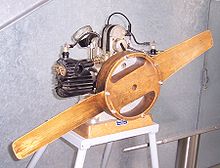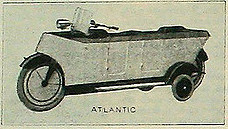Atlantic single lane wagon
| Atlantic | |
|---|---|
|
Atlantic single-track car, 1921
|
|
| Single lane car | |
| Production period: | 1921-1922 |
| Class : | Small car |
| Body versions : | Roadster |
| Engines: |
Otto engine : 0.5 liters (3–4.8 kW) |
| Length: | |
| Width: | |
| Height: | |
| Wheelbase : | |
| Empty weight : | 220 kg |
The Atlantic single-track car was an automobile of unusual design.
Manufacturers and distributors
The manufacturer was Atlantic AG für Automobilbau , based at Motzstrasse 8 in Berlin . In a communication from September 1922, the company gave the address Bessemerstraße 2 in Berlin-Tempelhof .
Wendriner Aktiengesellschaft from Berlin mentions an advertisement for the vehicle as a general distributor. Another source indicates that Wendriner AG was the parent company. This company was founded in 1912 as Berliner Automobil-Fuhrwesen and renamed Berliner Automobil-Betriebshandelsgesellschaft Wendriner GmbH in 1914 . At the time, Ilse Wendriner and Adolf Koerber were shareholders and Georg Wendriner was managing director. In 1919 there were personnel changes. Hans Wendriner, Ilse Barschall and Ernst Canter were shareholders, Hans Wendriner also managing directors. In 1921 the name was changed to Wendriner AG für Automobilbetrieb and Ulrich Wendriner was accepted as a further partner. In 1927 or 1933 the company was deleted from the commercial register.
Presentations and construction time
The vehicle was presented in 1921 at the Technical Fair on the grounds of the Old Leipzig Trade Fair in Leipzig .
Another presentation took place on the occasion of the 14th International Motor Show in Berlin . This fair ran from September 23 to October 2, 1921. However, the vehicle was not shown in the exhibition halls, but demonstrated on the exhibition grounds.
In September 1922, the company announced that it also wanted to exhibit at a trade fair in Frankfurt am Main from October 8 to October 14, 1922.
Production ran from 1921 to 1922 and marketing until 1923. Sales remained limited. According to one source, it was not possible to establish a national distribution. No more than 100 vehicles were sold, according to a source. Other sources do not provide any information on the production number.
description
The vehicle was a single lane car . The 28- inch front and rear wheels ran in one track. Two side support wheels measuring 15 inches provided stability when standing. They were attached just in front of the rear wheel and could be pulled up on a lever while driving after a step. The front and rear wheels were sprung. Like a motorcycle , the front wheel was used to steer.
The body was closed on the sides to the lower edge of the windshield and open above. It offered space for two people in a row on upholstered seats. There were two doors on the left side of the vehicle. The right side is not shown. A retractable hood was available on request.
There are images of different designs. One had relatively tall doors that reached almost to the running board and round rear fenders for the training wheels. Another had smaller doors that started above the now angular rear fenders.

The air-cooled two - cylinder boxer engine of the type BMW M 2 B 15 came from BMW . A 68 mm bore and 68 mm stroke resulted in a displacement of 494 cc . It was specified with 1.8 tax horsepower and 4 hp . According to other sources it is 6 hp or 6.5 hp. The ignition came from Robert Bosch GmbH . The engine was mounted horizontally and drove the rear wheel via a two-speed gearbox and a chain.
The curb weight was given as 220 kg. When fully occupied, a top speed of 70 km / h was possible. The fuel consumption was around 3.5 liters per 100 kilometers. The tank should allow a range of 500 kilometers. This suggests a tank capacity of 17.5 liters. A tank twice as large was available on request.
literature
- Peter Kirchberg: Automobile constructions. Part 1. The best of: "The motor car. 1902–1922." Steiger Verlag, Moers 1988, ISBN 3-925952-04-7 , pp. 203-205.
Web links
Individual evidence
- ↑ a b c d e f Harald H. Linz, Halwart Schrader : The International Automobile Encyclopedia . United Soft Media Verlag, Munich 2008, ISBN 978-3-8032-9876-8 , Chapter Atlantic (II).
- ↑ Advertisement for the vehicle (accessed on September 2, 2018)
- ↑ a b Message from Atlantic 1922 (accessed on August 26, 2018)
- ↑ a b Ulrich Kubisch : German car brands from A – Z. VF Verlagsgesellschaft, Mainz 1993, ISBN 3-926917-09-1 , p. 11.
- ↑ Cristina Herbst, Helwig Pringsheim: Diaries. 1905-1910. Wallstein Verlag, Göttingen 2015, ISBN 978-3-8353-2717-7 , pp. 850-851. available online (accessed on August 26, 2018)
- ↑ a b c d e f g Peter Kirchberg: Automobile constructions. Part 1. The best of: "The motor car. 1902–1922." Steiger Verlag, Moers 1988, ISBN 3-925952-04-7 , pp. 203-205.
- ↑ Version with round fenders (English, accessed on August 26, 2018)
- ↑ Version with square fenders (English, accessed on August 26, 2018)
- ↑ George Nicholas Georgano (Ed.): The Beaulieu Encyclopedia of the Automobile . Volume 1: A-F . Fitzroy Dearborn Publishers, Chicago 2001, ISBN 1-57958-293-1 , pp. 91 (English).
- ↑ GTÜ Society for Technical Monitoring (accessed on August 26, 2018)
